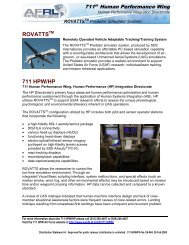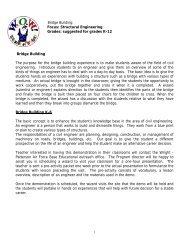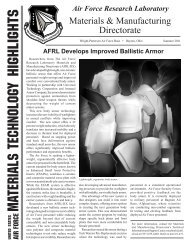3.7) <strong>The</strong> Five Pillars of TrigonometryLanguage is an innate human activity, andmathematics can be defined as the language ofmeasurement! This definition makes perfect sense, forhumans have been both measuring and speaking/writingfor a very long time. Truly, the need to measure is in our‘blood’ just as much as the need to communicate.Trigonometry initially can be thought of as the mathematicsof ‘how far’, or ‘how wide’, or ‘how deep’. All of the precedingquestions concern measurement, in particular, themeasurement of distance. Hence, trigonometry, as originallyconceived by the ancients, is primarily the mathematicalscience of measuring distance. In modern times,trigonometry has been found to be useful in scores of otherapplications such as the mathematical modeling andsubsequent analysis of any reoccurring or cyclic pattern.Geometry, particularly right-triangle or <strong>Pythagorean</strong>geometry, was the forerunner to modern trigonometry.Again, the ancients noticed that certain proportionsamongst the three sides of two similar triangles (triangleshaving equal interior angles) were preserved—no matter thesize difference between the two triangles. <strong>The</strong>se proportionswere tabulated for various angles. <strong>The</strong>y were then used tofigure out the dimensions of a large triangle using thedimensions of a smaller, similar triangle. This onetechnique alone allowed many powerful things to be donebefore the Common Era: e.g. construction of the GreatPyramid, measurement of the earth’s circumference (25,000miles in today’s terms), estimation of the distance from theearth to the moon, and the precise engineering of roadways,tunnels, and aqueducts. ‘Nascent trigonometry’, in the formof right-triangle geometry, was one of the backbones ofancient culture.In modern times trigonometry has grown far beyondits right triangle origins. It can now be additionallydescribed as the mathematics describing periodic or cyclicprocesses.116
One example of a periodic process is the time/distancebehavior of a piston in a gasoline engine as it repeats thesame motion pattern some 120,000 to 200,000 times in anormal hour of operation. Our human heart also exhibitsrepetitive, steady, and cyclic behavior when in good health.Thus, the heart and its beating motion can be analyzedand/or described using ideas from modern trigonometry ascan any electromagnetic wave form.Note: On a recent trip to Lincoln, Nebraska, I calculated that thewheel on our Toyota would revolve approximately 1,000,000 timesin a twelve-hour journey—very definitely a cyclic, repetitive process.Returning to measurement of distance, look up tothe night sky and think ‘how far to the stars’—much likeour technical ancestors did in ancient Greece, Rome,Babylon, etc. Trigonometry has answered that question inmodern times using the powerful parallax technique. <strong>The</strong>parallax technique is a marriage of modern and old: careful,precise measurement of known distances/anglesextrapolated across vast regions of space to calculate thedistance to the stars. <strong>The</strong> Greeks, Romans, andBabylonians would have marveled! Now look down at yourGPS hand-held system. Turn it on, and, within a fewseconds, you will know your precise location on planetearth. This fabulous improvement on the compass operatesusing satellites, electronics, and basic trigonometry asdeveloped from right triangles and the associated<strong>Pythagorean</strong> <strong>The</strong>orem. And if you do not have a GPS device,you surely have a cell phone. Every fascinating snippet ofcellular technology will have a mathematical foundation intrigonometry and the <strong>Pythagorean</strong> <strong>The</strong>orem.Trigonometry rests on five pillars that areconstructed using direct <strong>Pythagorean</strong> principles or derivatesthereof. <strong>The</strong>se five pillars serve as the foundation for thewhole study of trigonometry, and, from these pillars, onecan develop the subject in its entirety.Note: In 1970, while I was in graduate school, a mathematicsprofessor stated that he could teach everything that there is to knowabout trigonometry in two hours. I have long since realized that heis right. <strong>The</strong> five <strong>Pythagorean</strong> pillars make this statement so.117
- Page 1:
The PythagoreanTheoremCrown Jewel o
- Page 4:
The Pythagorean TheoremCrown Jewel
- Page 7 and 8:
Table of ContentsList of Tables and
- Page 9 and 10:
List of Tables and FiguresTablesNum
- Page 11 and 12:
Figures…continuedNumber and Title
- Page 13 and 14:
List of Proofs and DevelopmentsSect
- Page 15 and 16:
PrefaceThe Pythagorean Theorem has
- Page 17 and 18:
1 : 2x2x2****22 13x 7 13x 7 0 : a
- Page 19 and 20:
1) Consider the Squares“If it was
- Page 21 and 22:
s090045 0ss45450450090Figure 1.3: O
- Page 23 and 24:
Notice that the right-triangle prop
- Page 25 and 26:
The middle square (minus the donut
- Page 27 and 28:
Our proof in Chapter 1 has been by
- Page 29 and 30:
2) Four Thousand Years of Discovery
- Page 31 and 32:
The proof Pythagoras is thought to
- Page 33 and 34:
cabcFigure 2.4: Annotated Square wi
- Page 35 and 36:
Figure 2.6 is the diagram for a sec
- Page 37 and 38:
1x:b2:Area(CBA)3:Area( ABC)Area(ABC
- Page 39 and 40:
Euclid’s proof of the Pythagorean
- Page 41 and 42:
First we establish that the two tri
- Page 43 and 44:
1 2y b b: y b c c2:A3:A4:Aunshaded
- Page 45 and 46:
XB'A090 CBFigure 2.12: Euclid’s C
- Page 47 and 48:
2.3) Liu Hui Packs the SquaresLiu H
- Page 49 and 50:
One of my favorites was Boxel, a ga
- Page 51 and 52:
2.4) Kurrah Transforms the Bride’
- Page 53 and 54:
Note: as is the occasional custom i
- Page 55 and 56:
2.5) Bhaskara Unleashes the Power o
- Page 57 and 58:
2.6) Leonardo da Vinci’s Magnific
- Page 59 and 60:
In Figure 2.24, we enlarge Step 5 a
- Page 61 and 62:
But, this is precisely the nature o
- Page 63 and 64:
2.8) Henry Perigal’s TombstoneHen
- Page 65 and 66:
In the century following Perigal, b
- Page 67 and 68: Returning to Henry Perigal, Figure
- Page 69 and 70: Figure 2.32 is President Garfield
- Page 71 and 72: Even though the Cartesian coordinat
- Page 73 and 74: B 2← γ →α y βx C-xC 2Figure
- Page 75 and 76: Being polynomial in form, the funct
- Page 77 and 78: Thus, the critical point ( C 2 ,0)i
- Page 79 and 80: Sincexcpwas chosen on an arbitrary
- Page 81 and 82: ∂F/∂x = ∂F/∂y = 0x(C - x) 2
- Page 83 and 84: Define a new function21 A2 A3 2xcp
- Page 85 and 86: 2.11) Shear, Shape, and AreaOur las
- Page 87 and 88: Step 1: Cut the big square into two
- Page 89 and 90: In Table 2.3, we briefly summarize
- Page 91 and 92: We can formally state this similari
- Page 93 and 94: What we will do in Section 3.2 is p
- Page 95 and 96: There are three Pythagorean-triple
- Page 97 and 98: Thus, if we multiply any given prim
- Page 99 and 100: The last equality shows that the in
- Page 101 and 102: A Pythagorean Quartet is a set of f
- Page 103 and 104: 3.5) Pythagoras and the Three Means
- Page 105 and 106: yxy MHxab2ab2 y x FC y ab2ab 2ab y
- Page 107 and 108: Hero was the founder of the Higher
- Page 109 and 110: 5 : Solve for area using the formul
- Page 111 and 112: 4 : Construct the parallelogram wit
- Page 113 and 114: We already have introduced Thabit i
- Page 115 and 116: Some historians believe Stewart’s
- Page 117: In pre-computer days, both all four
- Page 121 and 122: The six trigonometric functions are
- Page 123 and 124: The following four relationships ar
- Page 125 and 126: As with any set of identities, the
- Page 127 and 128: Figure 3.17 can be used as a jumpin
- Page 129 and 130: The remaining two pillars are the L
- Page 131 and 132: a2Law of Cosines c2 b2 2bccos()The
- Page 133 and 134: An example of a Diophantine equatio
- Page 136 and 137: However, Euler’s Conjecture did n
- Page 138 and 139: 4) Pearls of Fun and WonderPearls o
- Page 140 and 141: We have achieved five-digit accurac
- Page 142 and 143: 140212213116)74370116)(74370(370)74
- Page 144 and 145: X X X X O X X O X XO X X O O OO X O
- Page 146 and 147: 4.3) Earth, Moon, Sun, and StarsIn
- Page 148 and 149: The four-step solution follows. All
- Page 150 and 151: Figure 4.9 depicts Eratosthenes’
- Page 152 and 153: ---High above the earth, we see the
- Page 154 and 155: The commonly accepted value is abou
- Page 156 and 157: 1BC : tan( BAC)BABC BAtan(BAC)0BC
- Page 158 and 159: BD ACtan( 21 )Even for the closest
- Page 160 and 161: 3w 2h s w 5 s w 0.38196s&5 1s
- Page 162 and 163: Figure 4.16: Triangular Phi---The h
- Page 164 and 165: What remains to be done is to devel
- Page 166 and 167: 3 : h32 4 h222 2 24C 2 h33162 2 2
- Page 168 and 169:
Epilogue: The Crown and the Jewels
- Page 170 and 171:
Not only has it endured, but the Py
- Page 172 and 173:
A] Greek AlphabetGREEK LETTERUpper
- Page 174 and 175:
C] Geometric FoundationsThe Paralle
- Page 176 and 177:
8. Congruent Triangles: Two triangl
- Page 178 and 179:
3. Rectangle: A bh : P 2b 2h, b &
- Page 180 and 181:
Recreational Mathematics11. Pickove
- Page 182 and 183:
GGolden RatioDefined and algebraica
- Page 184 and 185:
Puzzles (cont)Pythagorean Magic Squ
- Page 186 and 187:
Pythagorean Theorem ProofsAlgebraic
- Page 188:
Trigonometry (cont)Eratosthenes mea

















